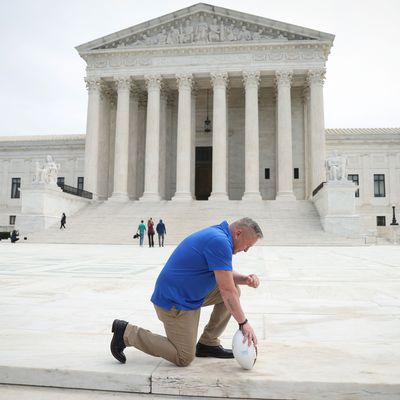
Since 1962, the U.S. Supreme Court has maintained that in most circumstances, public-school-sponsored prayer activity violates the First Amendment language prohibiting an “establishment of religion.” But the “wall of separation” between church and state that used to be the essence of the Establishment Clause is crumbling. In Monday’s Kennedy v. Bremerton decision, the Supreme Court’s conservative majority chipped away at precedents policing school prayer and other government entanglements with religion and continued its efforts — led as usual by Justice Neil Gorsuch — to subordinate the Establishment Clause to the language in the First Amendment protecting “free speech” and the “free exercise” of religion.
Bremerton involved a part-time assistant football coach at a public school who was holding prayer sessions on the 50-yard line after games. Gorsuch’s majority opinion treated coach Joseph Kennedy as an unobtrusive believer who was quietly and privately practicing his religious faith and was sometimes voluntarily joined by players and others — the sort of nonofficial prayer activity the courts had approved in the past. But as Vox’s Ian Millhiser explains, Gorsuch grossly distorted the facts of the case to make it fit the desired outcome:
In the real case that was actually before the Supreme Court, Coach Kennedy incorporated “motivational” prayers into his coaching. Eventually, these prayers matured into public, after-game sessions, where both Kennedy’s players and players on the other team would kneel around Kennedy as he held up helmets from both teams and led students in prayer. …
Kennedy also went on a media tour, presenting himself as a coach who “made a commitment with God” to outlets ranging from local newspapers to Good Morning America …
At the next game following this tour, coaches, players, and members of the public mobbed the field when Kennedy knelt to pray. A federal appeals court described this mob as a “stampede,” and the school principal said that he “saw people fall” and that, due to the crush of people, the district was unable “to keep kids safe.” Members of the school’s marching band were knocked over by the crowds.
Kennedy’s showboating has continued after the suspension he was clearly inviting. But Gorsuch didn’t simply mischaracterize the facts of the case; he also misstated the relevant precedents, dismissing a test for Establishment Clause cases followed by the Court since 1971 (which holds that government can assist religion only if (1) the primary purpose of the assistance is secular, (2) the assistance neither promotes nor inhibits religion, and (3) there is no excessive entanglement between church and state) as having already been “abandoned.” As Justice Sonia Sotomayor forcefully responded in a dissent joined by Justices Stephen Breyer and Elena Kagan, that’s simply not true, and worse yet, Gorsuch replaced the three-part test with a very vague standard measuring government entanglement with religion in terms of “history and tradition.”
The net effect, said Sotomayor, is to empty the Establishment Clause of its power to restrain government-sponsored religious expression:
The Free Exercise Clause and Establishment Clause are equally integral in protecting religious freedom in our society. The first serves as “a promise from our government,” while the second erects a “backstop that disables our government from breaking it” and “start[ing] us down the path to the past, when [the right to free exercise] was routinely abridged …”
Today, the Court once again weakens the backstop. It elevates one individual’s interest in personal religious exercise, in the exact time and place of that individual’s choosing, over society’s interest in protecting the separation between church and state, eroding the protections for religious liberty for all.
The vagueness of the Supreme Court’s new standard for measuring impermissible state-sponsored religious expression suggests that further damage to the wall separating church and state may be on the horizon. In a decision announced just a week ago, the Court’s same six conservatives went a long way toward not only allowing but compelling government subsidies for religious schools. They are in the process of reducing the Establishment Clause to a constitutional footnote rather than a guarantee that the United States would never limit religious liberty to those who go along with the beliefs and practices of a state regime.
More on the Supreme Court
- Trump’s Abortion Dodge Won’t Work in 2024
- The 14th Amendment Effort Only Ended Up Helping Trump
- Trump Finally Had a Good Day in Court






























